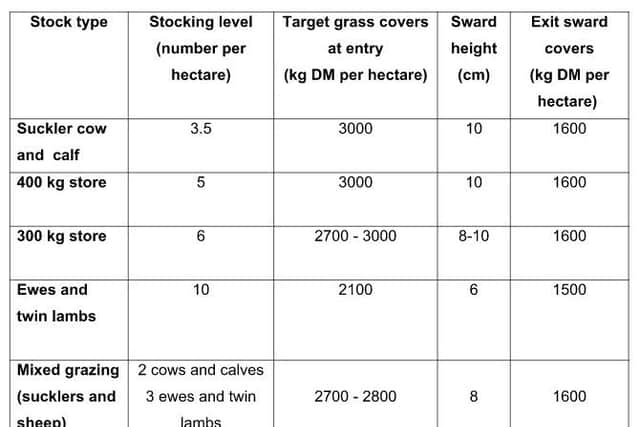DARD MANAGEMENT NOTES: Beef and sheep


As a guide this is when there is about two weeks supply of grass in front of them. Avoid keeping cattle housed until there is an oversupply of grass as this can quickly lead to more difficult grassland management.
Most of you will by now have sown N fertilizer on grazing areas and will be seeing the benefits of slurry applied in mid March. Urea fertiliser is the most cost effective form of N and can still be used where there is some grass cover and suitable moist conditions. In areas of low grass cover and drier conditions it is preferable to use other forms of N.
Close up land for silage production


Advertisement
Hide AdAdvertisement
Hide AdIf planning to cut silage at the start of June it is important to remove grazing stock from this land early April. Don’t be tempted to graze this land too tightly (under 5cm) before closing up for silage as this could potentially reduce grass growth rates and silage yields.
Protect against Grass Tetany
After turnout a major concern with suckler cows is Grass Tetany (‘staggers’) which is due to magnesium deficiency. As well as lactating cows it also can affect ewes and is often associated with high potash applications from fertilizer and slurry, particularly on soils that are already high in potash. The risk is greatest for animals under stress as a result of unpredictable weather and change of diet at this time of year.
Prevention involves ensuring animals have a daily supply of magnesium. This can be provided by:


* Adding magnesium to drinking water while making sure no other sources of water are available.
Advertisement
Hide AdAdvertisement
Hide Ad* Dusting magnesium (calcined magnesite) on the grazing pasture.
* Treating with magnesium boluses.
* Offering a 50:50 mix of calcined magnesite and molasses. Approximately 2.5 kg of the mix provides for 20 cows on a daily basis. Keep the mix stirred and top-up regularly.
* Magnesium licks or blocks and/or feeding a high magnesium meal daily.
Young cattle
Young growing cattle benefit most from an earlier start to the grazing season and can be turned out when grass covers are lighter (1900-2000 kg dry matter per hectare (7-8 cm high). Start at a low stocking rate of 1000 kg per hectare.
Suckler cows
Advertisement
Hide AdAdvertisement
Hide AdSuckler cows and calves should be on grass when ground conditions allow and ideally when average grass covers are 2200 kg dry matter per hectare (9 cm).
Rotational grazing
For most beef and sheep farms, moving stock every three days achieves efficient grass utilisation. This means for a 21 day rotational system, six to seven grazing areas are recommended. To manage grass covers efficiently you need to know how much grass is left on the grazing area on a weekly basis. In the early part of the season this can be achieved by grass measurements and by assessing the grazing days ahead. The grazing days ahead should be within the range of 12-15 days. The stocking level depends on sward quality, growth rates and soil fertility levels. The table below provides a general guide on stocking levels:
Guide to stocking levels and sward covers April to July (assuming an annual application of 150 kg N per hectare)
Stocking rate
Overstocking reduces grass growth and livestock performance. Understocking may maximise livestock performance in the early part of the grass year. However sward quality quickly deteriorates as the season progresses resulting in poorer utilisation and reduced livestock performance later in the year.